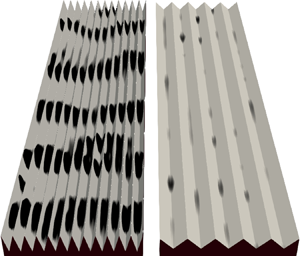Article contents
Influence of riblet shapes on the occurrence of Kelvin–Helmholtz rollers
Published online by Cambridge University Press: 02 March 2021
Abstract

We investigate turbulent flow over streamwise-aligned riblets (grooves) of various shapes and sizes. Small riblets with spacings of typically less than  $20$ viscous units are known to reduce skin-friction drag compared to a smooth wall, but larger riblets allow inertial-flow mechanisms to appear and cause drag reduction to break down. One of these mechanisms is a Kelvin–Helmholtz instability that García-Mayoral & Jiménez (J. Fluid Mech., vol. 678, 2011, pp. 317–347) identified in turbulent flow over blade riblets. In order to evaluate its dependence on riblet shape and thus gain a broader understanding of the underlying physics, we generate an extensive data set comprising 21 cases using direct numerical simulations of fully developed minimal-span channel flow. The data set contains six riblet shapes of varying sizes between maximum drag reduction and significant drag increase. Comparing the flow fields over riblets to that over a smooth wall, we find that in this data set only large sharp-triangular and blade riblets have a drag penalty associated with the Kelvin–Helmholtz instability and that the mechanism appears to be absent for blunt-triangular and trapezoidal riblets of any size. We therefore investigate two indicators for the occurrence of Kelvin–Helmholtz rollers in turbulent flow over riblets. First, we confirm for all six riblet shapes that the groove cross-sectional area in viscous units serves as a proxy for the wall-normal permeability that is necessary for the development of Kelvin–Helmholtz rollers. Additionally, we find that the occurrence of the instability correlates with a high momentum absorption at the riblet tips. The momentum absorption can be qualitatively predicted using Stokes flow.
$20$ viscous units are known to reduce skin-friction drag compared to a smooth wall, but larger riblets allow inertial-flow mechanisms to appear and cause drag reduction to break down. One of these mechanisms is a Kelvin–Helmholtz instability that García-Mayoral & Jiménez (J. Fluid Mech., vol. 678, 2011, pp. 317–347) identified in turbulent flow over blade riblets. In order to evaluate its dependence on riblet shape and thus gain a broader understanding of the underlying physics, we generate an extensive data set comprising 21 cases using direct numerical simulations of fully developed minimal-span channel flow. The data set contains six riblet shapes of varying sizes between maximum drag reduction and significant drag increase. Comparing the flow fields over riblets to that over a smooth wall, we find that in this data set only large sharp-triangular and blade riblets have a drag penalty associated with the Kelvin–Helmholtz instability and that the mechanism appears to be absent for blunt-triangular and trapezoidal riblets of any size. We therefore investigate two indicators for the occurrence of Kelvin–Helmholtz rollers in turbulent flow over riblets. First, we confirm for all six riblet shapes that the groove cross-sectional area in viscous units serves as a proxy for the wall-normal permeability that is necessary for the development of Kelvin–Helmholtz rollers. Additionally, we find that the occurrence of the instability correlates with a high momentum absorption at the riblet tips. The momentum absorption can be qualitatively predicted using Stokes flow.
JFM classification
Information
- Type
- JFM Papers
- Information
- Copyright
- © The Author(s), 2021. Published by Cambridge University Press
References
REFERENCES
- 54
- Cited by


